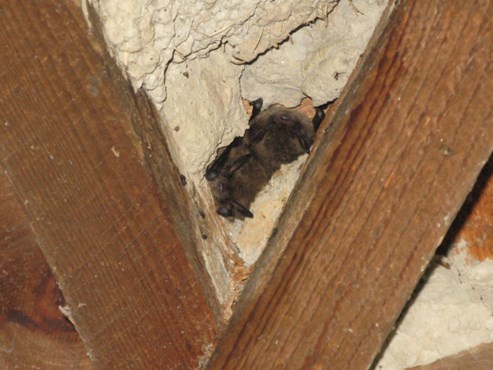
Bats are everywhere in America, and summer is when some species of bats gather in colonies to raise their young. Sometimes, they do this in human-made structures such as houses, barns and office buildings. That means that sometimes people wake up to discover a bat flying in their bedroom or roosting behind a loose board. It can be something of a shock, and sometimes the instinctive human response is to try to kill the bat. Here's what to do instead.
The reason biologists ask that people please avoid killing bats if possible is that there's a decent chance that the bat in question may be endangered. There are 15 species in the United States that are currently under protection.
How'd they get there? Well, bats can end up in your living space for many reasons. It may be young bats that are weak, disoriented or lost while coming and going from the roost, bats moving within a structure to find warmer or cooler roosting space as temperatures fluctuate, or bats being displaced from their roosts due to building repairs and renovations. 
Does the average bat in your home represent a danger to you? The long answer is complex, but the short answer is "probably not." There aren't any "vampire bats" (e.g., bats that primarily drink blood) in the United States, so you don't have to worry about a bat biting you because it's hungry. The primary danger from a bat bite would be rabies transmission, and rabies is relatively rarely found among bats.
Did you catch that "relatively" part? It's important. A full seventy percent of the cases of rabies in humans in the U.S. is from bat bites. Interestingly, the common pattern for bats with rabies is that they lose the ability to fly (or to fly well), so a bat on the wing is less likely to be rabid than one on the ground. (This may be part of why people get bitten; they see a bat that appears wounded and try to help it.)
Rabies is a deadly disease and should be taken very seriously. If you are concerned that you have been in direct contact with a bat, have found a bat in a bedroom while sleeping or in a room with an unattended child, a pet, a person with a cognitive disability, or an intoxicated person, please call the Rabies Hotline at 800-4RABIES (800-472-2437). Otherwise, here are some top-notch tips courtesy of the Vermont Fish & Wildlife Dept.
Individual bats occasionally enter houses, most often during evenings in July and August. These wayward bats are often the year's young that are just beginning to fly. If you encounter a bat flying in a room, make sure no person or pet has had contact with the bat. Capture the bat using the following methods, but do not release the bat if it was found in a room with a sleeping person, a previously unattended child, a mentally disabled/intoxicated person or an unvaccinated pet.
Is the bat flying? Remain calm! Do not chase or swat at the bat. This will only cause it to panic and fly erratically around the room. Shut all doors leading into other rooms to confine the bat to a single area. Remove pets from the room. Open all windows (without screens) and doors leading outside to give the bat a chance to escape. Don't worry about other bats coming in. Leave the lights on, stand quietly against a wall or door, and watch the bat to be sure it goes outside.
Don't try to herd it toward a window, and don't worry about it swooping at you. It's not attacking you; it's trying to get its bearings, and it won't get tangled in your hair. When indoors, bats make steep, banking turns, so it flies upward as it approaches a wall land then swoops lower in the center of the room. Once the bat figures things out--which should take 10 to 15 minutes--it will probably leave on its own. If it doesn't, wait for the bat to rest.
Is the bat at rest? Put on a pair of heavy leather or work gloves. Never handle a bat, or any other wild animal, with your bare hands. Place a container, such as a large plastic bowl or coffee can, over the bat as it rests on the wall. The bat will likely be exhausted and disoriented and should not fly when you approach it. Slide a piece of rigid cardboard (or a magazine or lid from a bowl) between the container and the wall to trap the bat. Hold the cardboard firmly against the container and carry it outside. If the bat is in a hard-to-reach place, use a fine-meshed insect net with a long pole.
Once you have captured the bat and are certain no people or pets have come into contact with it, place the container on its side on a secure place above the ground – such as on a ledge or against a tree. Be sure the opening is facing away from you, then slide away the cardboard. Releasing the bat above the ground will keep it safe from predators until it has its bearings. Unlike birds, most bats must drop from a perch and catch air under their wings before they can fly.
Bat colonies are starting to disperse now that young bats can fly. Fall is a good time of year to think about safely evicting bats from structures where they are not wanted. This is best left to professionals. Look for your state's fish and wildlife department website, and search for "bats." Most will have resources with professionals who can safely remove bats from your home.






































